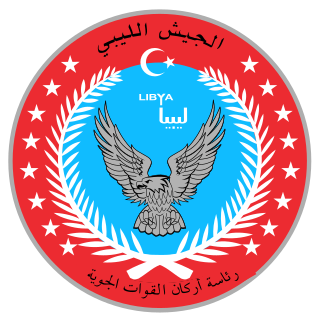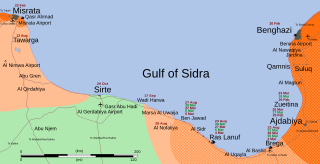
Sirte, also spelled Sirt, Surt, Sert or Syrte, is a city in Libya. It is located south of the Gulf of Sirte, between Tripoli and Benghazi. It is famously known for its battles, ethnic groups, and loyalty to Muammar Gaddafi. Due to developments in the First Libyan Civil War, it was briefly the capital of Libya as Tripoli's successor after the Fall of Tripoli from 1 September to 20 October 2011. The settlement was established in the early 20th century by the Italians, at the site of a 19th-century fortress built by the Ottomans. It grew into a city after World War II.

The Libyan Air Force is the branch of the Libyan Armed Forces responsible for aerial warfare. In 2010, before the Libyan Civil War, the Libyan Air Force personnel strength was estimated at 18,000, with an inventory of 374 combat-capable aircraft operating from 13 military airbases in Libya. Since the 2011 civil war and the ongoing conflict, multiple factions fighting in Libya are in possession of military aircraft. As of 2019 the Libyan Air Force is nominally under the control of the internationally recognised Government of National Accord in Tripoli, though the rival Libyan National Army of Marshal Khalifa Haftar also has a significant air force. In 2021, the air force is under command of the new President of Libya, Mohamed al-Menfi that replaced Fayez al-Sarraj.
Nofaliya or Nawfaliya is a town in the desert in the Sirte District of Libya. It is west of Libya's major oil ports.

The First Gulf of Sidra offensive was the second major rebel offensive of the Libyan Civil War. It was mounted by anti-Gaddafi forces immediately after their victory in the Battle of Ajdabiya. The offensive was meant to have the rebel forces quickly reach Gaddafi's hometown of Sirte.

The Second Gulf of Sidra offensive was a military operation in the First Libyan Civil War conducted by rebel anti-Gaddafi forces in August and September 2011 to take control of towns along the Gulf of Sidra in an effort to surround Muammar Gaddafi's hometown of Sirte, which was held by pro-Gaddafi forces. It ended on 20 October, with the capture and execution of Muammar Gaddafi and his son Mutassim Gaddafi, along with former defense minister Abu-Bakr Yunis Jabr. The Gaddafi loyalists in the area were finally defeated when NTC fighters captured Sirte.

The Libyan civil war (2014–2020), also more commonly known as the Second Libyan Civil War, was a multilateral civil war which was fought in Libya between a number of armed groups, but mainly the House of Representatives (HoR) and the Government of National Accord, for six years from 2014 to 2020.

Many states began to intervene against the Islamic State, in both the Syrian Civil War and the War in Iraq (2013–2017), in response to its rapid territorial gains from its 2014 Northern Iraq offensives, universally condemned executions, human rights abuses and the fear of further spillovers of the Syrian Civil War. These efforts are called the war against the Islamic State, or the war against ISIS. In later years, there were also minor interventions by some states against IS-affiliated groups in Nigeria and Libya. All these efforts significantly degraded the Islamic State's capabilities by around 2019–2020. While moderate fighting continues in Syria, as of 2024, ISIS has been contained to a manageably small area and force capability.

The Shura Council of Benghazi Revolutionaries was a military coalition in Benghazi composed of Islamist and jihadist militias, including Ansar al-Sharia, Libya Shield 1, and several other groups.

In October 2014, the self-declared Islamic State of Iraq and the Levant (ISIL) took control of numerous government buildings, security vehicles and local landmarks in the Eastern Libyan coastal city of Derna. Although some media outlets reported the control as being absolute, rival groups like the al-Qaeda-affiliated Abu Salim Martyrs Brigade continued to control parts of the city. Clashes erupted between ISIL and an alliance of Islamist groups in June 2015, with ISIL retreating from Derna to outlying suburbs the following month. However, clashes continued between the Islamist alliance and the Tobruk-based government forces.

The Islamic State (IS) had its core in Iraq and Syria from 2013 to 2017 and 2019 respectively, where the proto-state controlled significant swathes of urban, rural, and desert territory, mainly in the Mesopotamian region. Today the group controls scattered pockets of land in the area, as well as territory or insurgent cells in other areas, notably Afghanistan, West Africa, the Sahara, Somalia, Mozambique, and the Democratic Republic of the Congo. As of 2023, large swathes of Mali have fallen under IS control.

The Libyan Crisis is the current humanitarian crisis and political-military instability occurring in Libya, beginning with the Arab Spring protests of 2011, which led to two civil wars, foreign military intervention, and the ousting and death of Muammar Gaddafi. The first civil war's aftermath and proliferation of armed groups led to violence and instability across the country, which erupted into renewed civil war in 2014. The second war lasted until October 23, 2020, when all parties agreed to a permanent ceasefire and negotiations.
The February 2015 Egyptian airstrikes in Libya against Islamic State positions in Libya took place on 16 February 2015, and were triggered by a video released by ISIL in Libya a day earlier, depicting the beheading of 21 Coptic Christians from Egypt. Within hours, the Egyptian Air Force responded with airstrikes against ISIL training camps and weapons stockpiles in retaliation for the killings. Warplanes acting under orders from the Libyan government also struck targets in Derna, reportedly in coordination with Egypt.

The Battle of Sirte refers to the battle in the spring of 2015, in the region of Sirte, Libya, between the Islamic State of Iraq and the Levant (ISIL) and the Libya Shield Force. ISIL forces had been present in the city since February 2015, before the Fall of Nofaliya. After Nofaliya fell to ISIL forces, the Tripoli-based government had decided to send reinforcements to recapture Sirte.

The Islamic State – Libya Province is a militant Islamist group active in Libya under three branches: Fezzan Province in the desert south, Cyrenaica Province in the east, and Tripolitania Province in the west. The branches were formed on 13 November 2014, following pledges of allegiance to IS leader Abu Bakr al-Baghdadi by militants in Libya.
This is a detailed timeline of the Libyan civil war (2014–2020) which lasted from 2014 to 2020.

The Battle of Sirte during the Second Libyan Civil War started in the spring of 2016, in the Sirte District of Libya, between the Islamic State of Iraq and the Levant (ISIL) and the loyalist forces of the Government of National Accord (GNA) backed by the United States. ISIL forces had captured Sirte one year earlier, during the previous battle. The conflict for Sirte was described as ISIL's "last stand" in Libya.
Fall of Bin Jawad (2016) refers to ISIL takeover of Libyan city of Bin Jawad on 4 January 2016 during its oil crescent region. On Monday morning, the terrorist group imposed full control over the city of Bin Jawad in the Sirte District, after a series of intense firefights with rebel forces that are loyal to the Libyan provisional government in Tripoli.

From November 2015 to 2019, the United States and allies carried out a large series of both airstrikes and drone strikes to intervene in Libya in its revived conflict in support of the Tripoli-based Government of National Accord against the ISIL presence in the region. By 2019, the ISIL branch had been largely driven from holding Libyan territory, and US strikes ceased.
Katiba al-Bittar al-Libi is an armed Islamist group operating in Iraq, Syria and Libya. The group is composed largely of Libyan fighters who entered Syria in the wake of the Arab Spring and early post-civil uprising stage of the Syrian Civil War. Though the group is composed largely of Libyans, the group also has large amounts of Tunisians and Francophone Maghrebis from Europe, reportedly the perpetrators of the November 2015 Paris attacks and Manchester Arena bombing, including Abdelhamid Abaaoud, who was suspected to be a leader of the group, were members of the group or affiliated with it, the group also pioneered the Inghimasi tactic used in the attack, and its fighters have largely employed the tactic on the battlefield. The group maintained close ties to Ansar al-Sharia in Tunisia through networks in Libya and has established multiple training camps across Libya and has recruited Tunisians to these camps, which were located around Sirte and Tripoli. During beginning of the infighting between ISIL and its former allies such as Jabhat al-Nusra and Ahrar al-Sham fighters from Katiba al-Bittar took part in open fighting against ISIL's opponents in Markada and Atarib, in the process losing several fighters.











